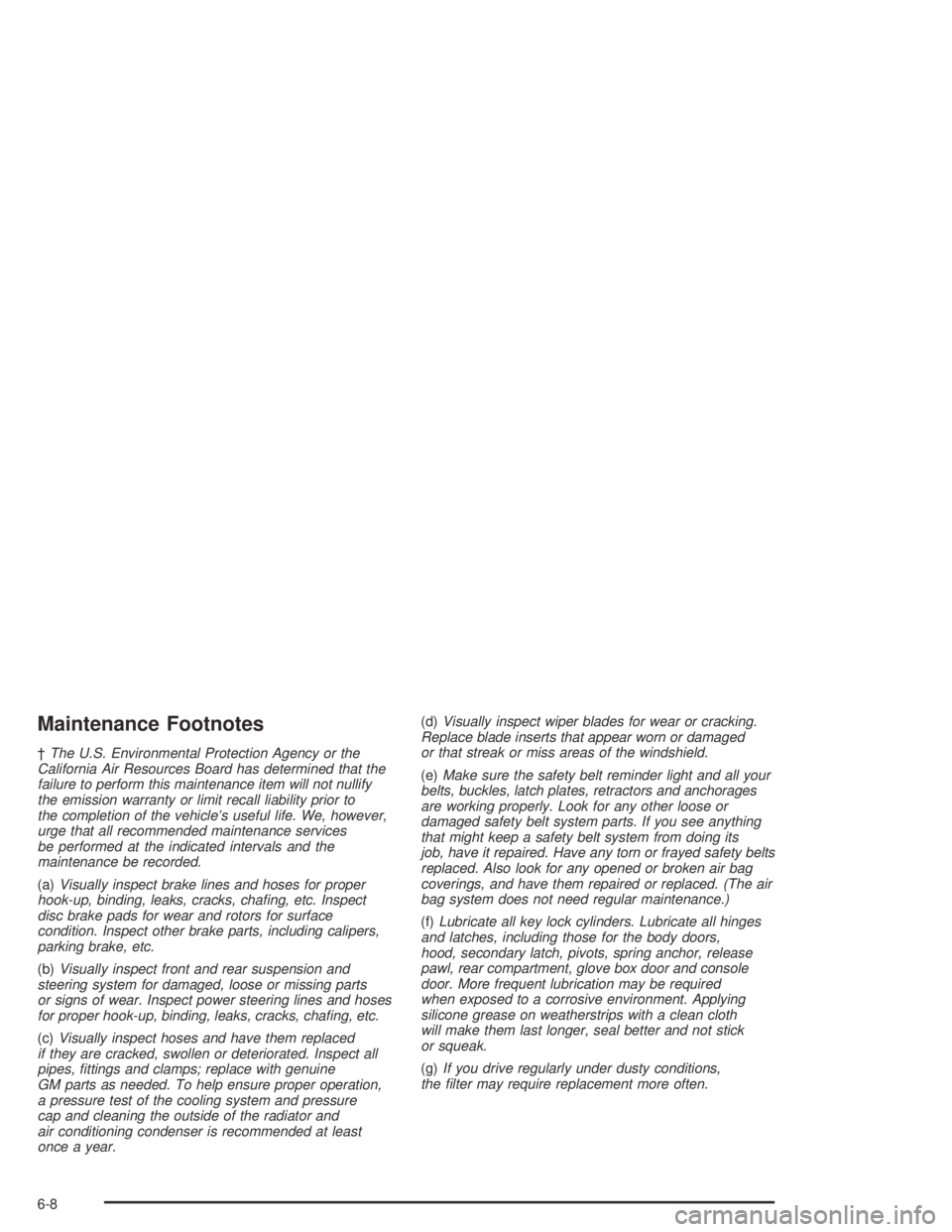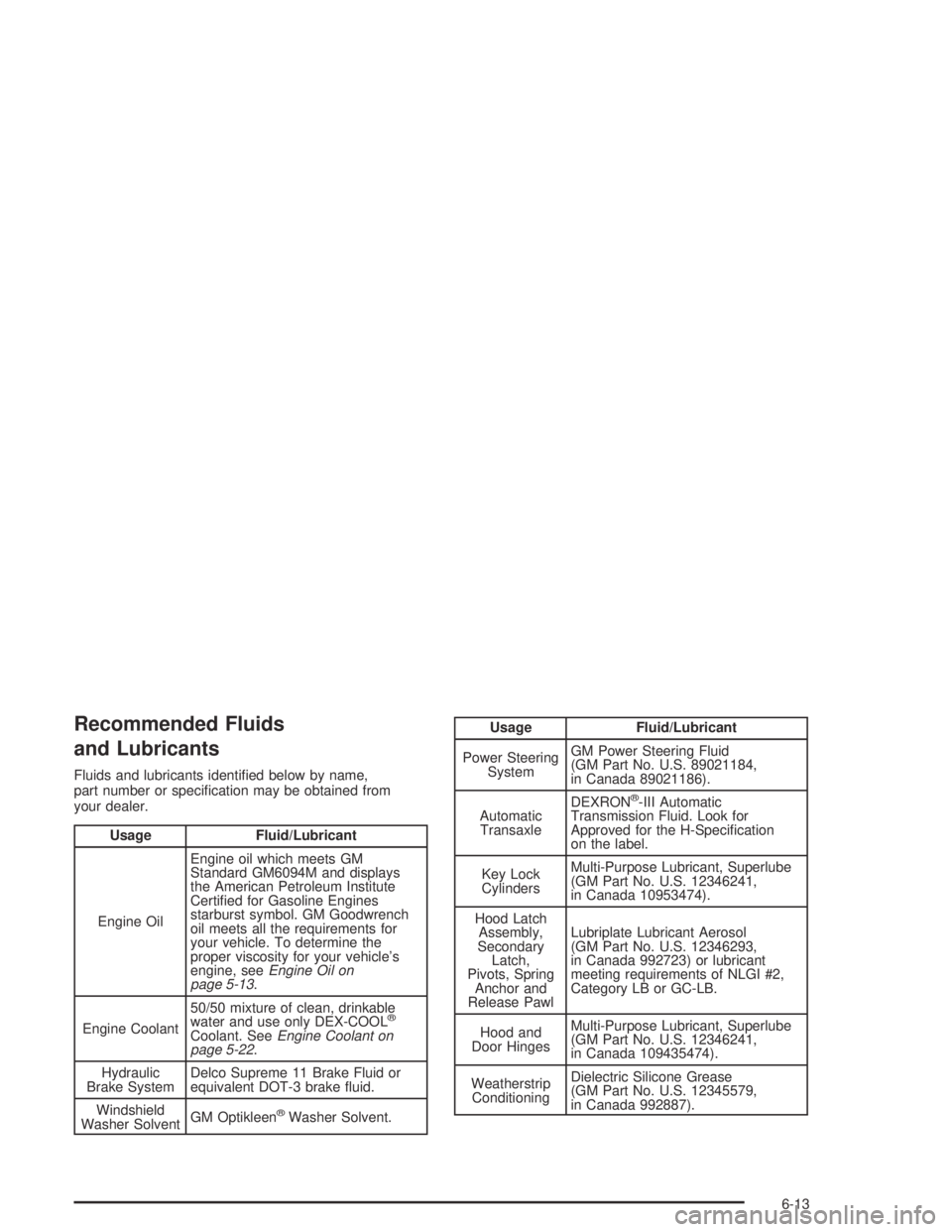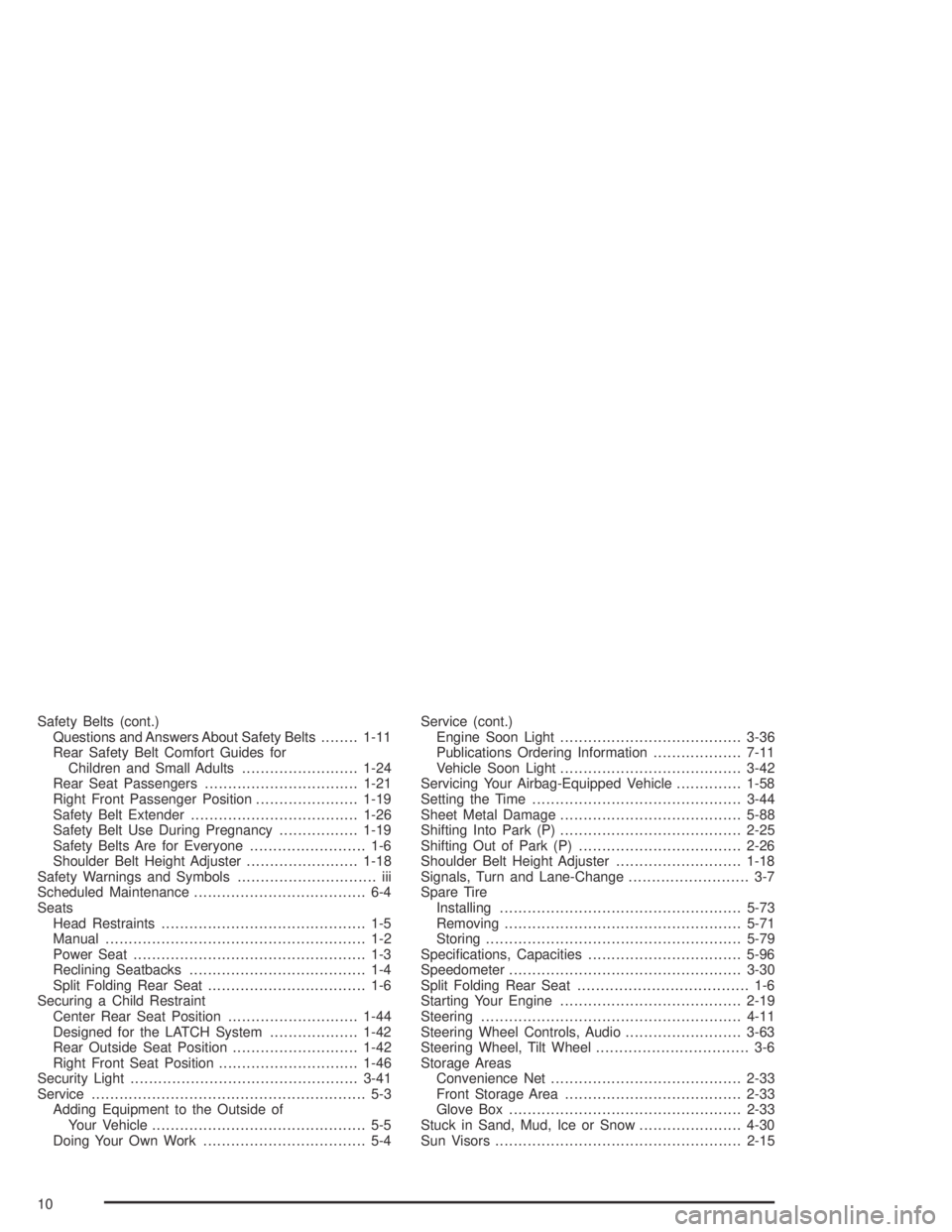2005 BUICK CENTURY power steering
[x] Cancel search: power steeringPage 303 of 348

Fuses Usage
Blank Not Used
R/LAMPS Taillamps, License Plate Lamps
Blank Not Used
Blank Not Used
CRUISE Cruise Control
Blank Not Used
CLSTR Instrument Panel Cluster
LTR Cigarette Lighter
STOP LAMPS Stoplamps
ONSTAR OnStar
®
PRK/LGHT Parking Lamps
Blank Not Used
CRNK SIG,
BCM, CLSTRCrank Signal, Body Control Module,
Cluster, Powertrain Control Module
HVACIgnition Signal, Heating, Ventilation,
and Air Conditioning Control Head
BTSI (REGAL) Not Used
AIR BAG Air Bag
Fuses Usage
BCM PWR Body Control Module
HAZARD Hazard Warning Flashers
LH HTD SEAT Not Used
Blank Not Used
BCM ACCYIgnition Signal: Hot in ACCESSORY
and RUN, Body Control Module
Blank Not Used
LOW BLWR Low Blower
ABS Anti-Lock Brakes
TRN SIG Turn Signals, Cornering Lamps
RADIO, HVAC,
RFA, CLSTR
ALDLRadio, Heating Ventilation and
Air Conditioning Head; Remote
Keyless Entry, Cluster
HI BLWR High Blower
RH HTD SEAT Not Used
STR/WHL/
CNTRLAudio Steering Wheel Controls
WPR Windshield Wipers
5-93
Page 304 of 348

Underhood Fuse Block
Some fuses and relays are located in the underhood
fuse block on the passenger’s side of the vehicle in the
engine compartment. SeeEngine Compartment
Overview on page 5-12for more information on location.
Fuses Usage
1 Anti-Lock Brake System
2 Starter Solenoid
3 Power Seat, Rear Window Defogger
4High Blower, Hazard Flasher,
Stoplamps, Power Mirror,
Door Locks
Fuses Usage
5Ignition Switch, Stoplamps,
Anti-Lock Brake System, Turn
Signals, Cluster, Air Bag, Daytime
Running Lamps Module
6 Cooling Fan
7Retained Accessory Power,
Remote Keyless Entry, Data Link,
Heating, Ventilation, and Air
Conditioning Head; Cluster, Radio,
Cigarette Lighter
8Ignition Switch, Wipers, Audio
Steering Wheel Controls, Body
Control Module, Power Windows,
Sunroof, Heating, Ventilation, and
Air Conditioning Controls; Daytime
Running Lamps, Rear Window
Defogger Relay
Relays Usage
9 Cooling Fan 2
10 Cooling Fan 3
11 Starter Solenoid
12 Cooling Fan 1
13 Ignition Main
14 Air Pump (Optional)
5-94
Page 314 of 348

Maintenance Footnotes
†The U.S. Environmental Protection Agency or the
California Air Resources Board has determined that the
failure to perform this maintenance item will not nullify
the emission warranty or limit recall liability prior to
the completion of the vehicle’s useful life. We, however,
urge that all recommended maintenance services
be performed at the indicated intervals and the
maintenance be recorded.
(a)Visually inspect brake lines and hoses for proper
hook-up, binding, leaks, cracks, cha�ng, etc. Inspect
disc brake pads for wear and rotors for surface
condition. Inspect other brake parts, including calipers,
parking brake, etc.
(b)Visually inspect front and rear suspension and
steering system for damaged, loose or missing parts
or signs of wear. Inspect power steering lines and hoses
for proper hook-up, binding, leaks, cracks, cha�ng, etc.
(c)Visually inspect hoses and have them replaced
if they are cracked, swollen or deteriorated. Inspect all
pipes, �ttings and clamps; replace with genuine
GM parts as needed. To help ensure proper operation,
a pressure test of the cooling system and pressure
cap and cleaning the outside of the radiator and
air conditioning condenser is recommended at least
once a year.(d)Visually inspect wiper blades for wear or cracking.
Replace blade inserts that appear worn or damaged
or that streak or miss areas of the windshield.
(e)Make sure the safety belt reminder light and all your
belts, buckles, latch plates, retractors and anchorages
are working properly. Look for any other loose or
damaged safety belt system parts. If you see anything
that might keep a safety belt system from doing its
job, have it repaired. Have any torn or frayed safety belts
replaced. Also look for any opened or broken air bag
coverings, and have them repaired or replaced. (The air
bag system does not need regular maintenance.)
(f)Lubricate all key lock cylinders. Lubricate all hinges
and latches, including those for the body doors,
hood, secondary latch, pivots, spring anchor, release
pawl, rear compartment, glove box door and console
door. More frequent lubrication may be required
when exposed to a corrosive environment. Applying
silicone grease on weatherstrips with a clean cloth
will make them last longer, seal better and not stick
or squeak.
(g)If you drive regularly under dusty conditions,
the �lter may require replacement more often.
6-8
Page 319 of 348

Recommended Fluids
and Lubricants
Fluids and lubricants identi�ed below by name,
part number or speci�cation may be obtained from
your dealer.
Usage Fluid/Lubricant
Engine OilEngine oil which meets GM
Standard GM6094M and displays
the American Petroleum Institute
Certi�ed for Gasoline Engines
starburst symbol. GM Goodwrench
oil meets all the requirements for
your vehicle. To determine the
proper viscosity for your vehicle’s
engine, seeEngine Oil on
page 5-13.
Engine Coolant50/50 mixture of clean, drinkable
water and use only DEX-COOL
®
Coolant. SeeEngine Coolant on
page 5-22.
Hydraulic
Brake SystemDelco Supreme 11 Brake Fluid or
equivalent DOT-3 brake �uid.
Windshield
Washer SolventGM Optikleen
®Washer Solvent.
Usage Fluid/Lubricant
Power Steering
SystemGM Power Steering Fluid
(GM Part No. U.S. 89021184,
in Canada 89021186).
Automatic
TransaxleDEXRON
®-III Automatic
Transmission Fluid. Look for
Approved for the H-Speci�cation
on the label.
Key Lock
CylindersMulti-Purpose Lubricant, Superlube
(GM Part No. U.S. 12346241,
in Canada 10953474).
Hood Latch
Assembly,
Secondary
Latch,
Pivots, Spring
Anchor and
Release PawlLubriplate Lubricant Aerosol
(GM Part No. U.S. 12346293,
in Canada 992723) or lubricant
meeting requirements of NLGI #2,
Category LB or GC-LB.
Hood and
Door HingesMulti-Purpose Lubricant, Superlube
(GM Part No. U.S. 12346241,
in Canada 109435474).
Weatherstrip
ConditioningDielectric Silicone Grease
(GM Part No. U.S. 12345579,
in Canada 992887).
6-13
Page 341 of 348

Event Data Recorders (EDR)............................. 7-9
Extender, Safety Belt.......................................1-26
Exterior Lamps...............................................3-13
F
Filter
Engine Air Cleaner......................................5-18
Finish Damage...............................................5-88
Fixed Mast Antenna........................................3-66
Flash-to-Pass................................................... 3-8
Flat Tire........................................................5-69
Flat Tire, Changing.........................................5-70
Flat Tire, Storing.............................................5-79
Fluid
Automatic Transaxle.....................................5-19
Power Steering...........................................5-34
Windshield Washer......................................5-35
Folding Rear Seat............................................ 1-6
Front Storage Area.........................................2-33
Fuel............................................................... 5-5
Additives...................................................... 5-6
California Fuel.............................................. 5-6
Filling a Portable Fuel Container....................5-10
Filling Your Tank........................................... 5-8
Fuels in Foreign Countries.............................. 5-7
Gage.........................................................3-42
Gasoline Octane........................................... 5-5Fuel (cont.)
Gasoline Speci�cations.................................. 5-5
Low Warning Light.......................................3-43
Fuses
Fuses and Circuit Breakers...........................5-91
Instrument Panel Fuse Block.........................5-91
Underhood Fuse Block.................................5-94
Windshield Wiper.........................................5-91
G
Gage
Engine Coolant Temperature.........................3-35
Fuel..........................................................3-42
Speedometer..............................................3-30
Gasoline
Octane........................................................ 5-5
Speci�cations............................................... 5-5
Glove Box.....................................................2-33
GM Mobility Program for Persons
with Disabilities............................................. 7-6
H
Hazard Warning Flashers................................... 3-6
Head Restraints............................................... 1-5
Headlamp
Aiming.......................................................5-45
5
Page 344 of 348

Malfunction Indicator Light................................3-36
Manual Seats................................................... 1-2
Mirrors
Manual Rearview Mirror................................2-29
Manual Rearview Mirror with OnStar
®.............2-29
Outside Convex Mirror.................................2-30
Outside Power Mirrors..................................2-30
MyGMLink.com................................................ 7-4
N
New Vehicle Break-In......................................2-17
Normal Maintenance Replacement Parts............6-14
O
Odometer......................................................3-30
Odometer, Trip...............................................3-30
Off-Road Recovery..........................................4-13
Oil
Change Engine Oil Light...............................3-40
Engine.......................................................5-13
Pressure Light.............................................3-40
Older Children, Restraints................................1-27
Online Owner Center........................................ 7-4
OnStar
®System.............................................2-31
Other Warning Devices...................................... 3-6Outlet Adjustment............................................3-26
Outside
Convex Mirror.............................................2-30
Power Mirrors.............................................2-30
Overheated Engine Protection
Operating Mode..........................................5-26
Owner Checks and Services.............................. 6-9
Owners, Canadian............................................... ii
P
Park (P)
Shifting Into................................................2-25
Shifting Out of............................................2-26
Parking
Brake........................................................2-24
Over Things That Burn.................................2-27
Passenger Compartment Air Filter.....................3-26
Passing.........................................................4-13
PASS-Key
®II .................................................2-16
Power
Door Locks.................................................2-11
Electrical System.........................................5-91
Retained Accessory (RAP)............................2-19
Seat............................................................ 1-3
Steering Fluid.............................................5-34
Windows....................................................2-15
Programmable Automatic Door Locks.................2-11
8
Page 346 of 348

Safety Belts (cont.)
Questions and Answers About Safety Belts........1-11
Rear Safety Belt Comfort Guides for
Children and Small Adults.........................1-24
Rear Seat Passengers.................................1-21
Right Front Passenger Position......................1-19
Safety Belt Extender....................................1-26
Safety Belt Use During Pregnancy.................1-19
Safety Belts Are for Everyone......................... 1-6
Shoulder Belt Height Adjuster........................1-18
Safety Warnings and Symbols.............................. iii
Scheduled Maintenance..................................... 6-4
Seats
Head Restraints............................................ 1-5
Manual........................................................ 1-2
Power Seat.................................................. 1-3
Reclining Seatbacks...................................... 1-4
Split Folding Rear Seat.................................. 1-6
Securing a Child Restraint
Center Rear Seat Position............................1-44
Designed for the LATCH System...................1-42
Rear Outside Seat Position...........................1-42
Right Front Seat Position..............................1-46
Security Light.................................................3-41
Service........................................................... 5-3
Adding Equipment to the Outside of
Your Vehicle.............................................. 5-5
Doing Your Own Work................................... 5-4Service (cont.)
Engine Soon Light.......................................3-36
Publications Ordering Information...................7-11
Vehicle Soon Light.......................................3-42
Servicing Your Airbag-Equipped Vehicle..............1-58
Setting the Time.............................................3-44
Sheet Metal Damage.......................................5-88
Shifting Into Park (P).......................................2-25
Shifting Out of Park (P)...................................2-26
Shoulder Belt Height Adjuster...........................1-18
Signals, Turn and Lane-Change.......................... 3-7
Spare Tire
Installing....................................................5-73
Removing...................................................5-71
Storing.......................................................5-79
Speci�cations, Capacities.................................5-96
Speedometer..................................................3-30
Split Folding Rear Seat..................................... 1-6
Starting Your Engine.......................................2-19
Steering........................................................4-11
Steering Wheel Controls, Audio.........................3-63
Steering Wheel, Tilt Wheel................................. 3-6
Storage Areas
Convenience Net.........................................2-33
Front Storage Area......................................2-33
Glove Box..................................................2-33
Stuck in Sand, Mud, Ice or Snow......................4-30
Sun Visors.....................................................2-15
10